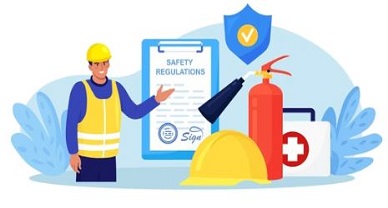Employment Injury – Statutory Obligation of Employer
ABSTRACT
Employers and employees both are affected by the significant consequences resulting out of an injury. Employment injury negatively affects the production, financial stability and over all functioning. Governments around all over the world have included certain statutory obligations on the employer with an intention to ensure the safety and security of the employees in the workplace. This paper provides a comprehensive overview of the statutory obligation mentioned under the occupational safety, health and working condition code of 2020 and under the code on social security Act of 2020. The paper delves into analysing the statutory obligations of an employer which are provided with the objective to compensate the employee who has suffered an injury. An attempt has been made to analyse preventive provisions related to the mandate of providing adequate training, safety equipment, safety guidelines and to provide safe working environment. Further attempt has been made to highlight the provisions regarding rehabilitation and compensation to the employees who have suffered injury at workplace. The study sheds light on the requirements which includes requirement of providing immediate medical assistance and reporting accidents. Certain provisions regarding the consequences in situation where the employer fails to perform duties and fails to provide safety and security to the employees are also been mentioned hereby.
RESEARCH METHODOLOGY
This study has adopted doctrinal and exploratory research methodology to develop this paper by taking into consideration the obligatory liabilities and responsibilities and current position of the world with respect to employment Injury and urgency to address it. This study has been done by referring to primary sources such as legislative enactments, reports and secondar sources such as books and other research papers.
INTRODUCTION
Employment injuries such as accidents such as machinery accidents, transportation accidence and other accidents at workplace, occupational decease, Musculo skeleton injury, cuts, bruises, lacerations, Mental health issues and fatal injuries on workplace come under the ambit of Employment Injury. As estimated by the International Labour Organization around 2.3 men and women suffer from employment injury which results to around 6000 deaths per year and at least worldwide, around 340 million occupational accidents and 160 million people who are victims of occupational illness have been recorded[1]. According to the findings of IOL around 651,279 deaths are caused due to the occupational diseases arising out of the hazardous substances[2], Majority of the accidents have been recorded in the construction industry. It has been observed that mostly the old and younger workers are highly vulnerable to employment injuries. In India around 1109 deaths and more than 4000 injuries in registered factories were recorded in 2017 to 2020[3]. The word employment injury is defined under the section 2 (28) of the code on social security as, employment injury includes the personal injury which is caused by occupational disease or accident which has aroused out of and in the course of his employment[4]. the defaunation further explains that the meaning of the “Employment Injury” for the purpose of chapter six and chapter 7 of the code the injury as per section 2(28) can be an accident which has occurred or occupational disease which has contracted within the territory of India or outside the territory of India[5]. Chapter six and seven of the social security code (2020) deals with worker duty regarding employee’s maternity benefit period and employee’s compensation respectively. further in the occupational safety and health working conditions code provides provisions to address the concerns regarding employment safety. This paper has made an attempt to address the research questions such as what is the statutory legal framework to address concern regarding employment Injury? what are the preventive statutory provisions mentioned in the statutes to prevent employment injury and lastly what are the challenges and possible solutions to enhance implementation of the existing provisions.
PREVENTIVE PROVISIONS IN INDIA
PROVSIONS UNDER OCCUPATIONAL SAFETY AND HEALTH WORKING CONDITIONS CODE
In India mainly two labour codes provide preventive framework for prevention of employment injuries. The occupational safety, health and working condition code was enacted in 2020 with the objective to consolidate laws in relation to occupational safety, working condition and health of the person employed in an establishment and also to address the matters which are incidental. Chapter III of this code provides mandatory duties of employer, section 6 of the code provides that it the duty of an employer to ensure that the work place is free from hazards which are likely to cause any employment Injury, to comply with section 18 ,the bye laws, regulations under this code regarding health and occupational safety standards, it is the duty of the employer to provide free heath tests or examinations to certain age of employees as per specifies by the government, to provide a safe working environment by ensuring proper disposal of hazardous waste and by ensuring that no cost regarding the safety measures provided by the employer is being charged, In case of work related to dock , mine or construction work it is the duty of the employer to maintain the plant , system for risk free environment, to ensure safety while storing , handling and transporting articles and substances, to provide adequate training , instructions and supervision and to maintain a risk free workplace for the employees[6]. Further in accordance to section 10 of the code provides that where an accident happens which has resulted in death or bodily injury to an employee by which he cannot work, in such circumstance a notice has to be sent regarding such accident[7]. Section 11 of the code provides that if there is any dangerous occurrence then it is the duty of the employer to give a notice regarding the occurrence to the appropriate authorities[8]. Section 12 of the code suggests that, in case where an employee contracts any disease mentioned under schedule 3 of the code then the employer is obligated to inform the authorities, the medical practitioner who is attending the employee who has been infected shall inform the inspector cum facilitator[9]. Further, Chapter IV of the code includes provisions related to occupational safety and health. A national and state occupational safety and health advisory board Is constituted by the central government under section 16 and 17 of the code respectively[10]. The occupational safety and health standards are mentioned under section 18 of the code. Section 23 of the code provides that the employer is obligated to maintain cleanliness , hygiene, temperature and humidity, ventilation, environment free from noxious gases , dust , fumes ad other impurities , portable water, standards to prevent overcrowding, adequate for latrine and urinal in the workplace and adequate accommodation of transgender, appropriate and sufficient lightning and adequate arrangement for disposal of waste and effluents and any other arrangements shall be made as per the central government deems fit to[11].Similarly section 24 of the code imposes responsibility on the employer to provide certain welfare facilities in the establishment. This code provides special safety measures to the women employees under chapter 10 of the code, further section 44 of the code provides that according to the requirement of appropriate government, the employer is obligated to provide adequate safeguards to the women employees when they are engaged in certain hazardous or dangerous process or work in the establishment[12]. Under section 63 of the code, a helpline number is provided for the interstate migrant workers by the central government to provide help in emergency situations. In case a person is visually impaired and deaf or has tendency of giddiness and the employer has the knowledge of the condition of such person then the employer shall not allow such person to work any operation related to construction and building work[13]. Section 93 of the code obligates an employer to provide safety measures in connection with transport, storage ad handling of pesticides, insecticides, toxic substances and any other hazardous chemical in every plantation , the employer of a plantation is obligated to appoint a qualified supervisor, every employer of plantations needs to ensure that the workers in the plantation are trained to deal with hazardous work and various safety measures have been adopted in emergency arising from any of the hazardous operations, the employer has an obligation to maintain health records of workers who work in dangerous operation and he shall further give the access of records to the workers, further as per this section every employer is obligated to provide facilities for safety such as protective clothing equipment, washing and bathing clock room facilities, a list of permissible concentration of hazardous material and any such precautionary notice shall be displayed by the employer[14].
CONSEQUENCES AS TO NON-COMPLIANCE BY EMPLOYER
The code provides certain penalties for noncompliance of the obligation mentioned under the code. Section 94 of the code provides that if there is any contravention to any of the provisions mentioned by the code, the employer shall be liable to penalty which shall not be less than two lakh rupees and which may extend not more than three lakh rupees and in case if the contravention continues the penalty shall not exceed more than two thousand for each day of contravention[15] . Further section 102 of the code provides that when there is a contradiction to any of the provisions in relation to the duties to regarding hazardous process , whosoever fails to comply shall be liable for imprisonment which can extend up to two years and with fine up to five lakh rupees and if the contravention continues then the person shall be liable for twenty five thousand rupees for each day the contravention has continued and is such contravention continues beyond one year then the person will be liable for three years of imprisonment and with or without fine which may not exceed twenty lakhs[16]. Section 103 of the code mentions about the penalty for non-compliance of the safety provisions regarding the accidents at workplace, this section suggests that if the noncompliance results into death then the person shall liable for three years of imprisonment or fine which may not extend to five lakh rupees or may be liable for both, In case the non-compliance results into any serious bodily injury at the workplace then the person shall be liable for imprisonment up to to two years or fine not less that two lakh rupees and up to four lakh rupees or with both, fixity percent of the fine shall be paid to the victim as compensation[17].
PROVISIONS UNDER SOCIAL SECURITY CODE
Unlike the other countries the provisions for social security are covered under the social security code which comes under the ambit of labour laws in India. Section 34 of the code suggests that any accident which occurs in the workplace where the victim is being working for the employer shall be presumed to be arisen out of the course of his employment if he is acting to prevent a larger mishap or helps and person who is likely suffer serious injury or to avoid serious damage to the property, further according to the section if the accident happens while commuting from the person’s residence to the workplace and from his workplace to his residence or travelling to any other place for work relating to his employment, it shall be assumed that the accident has taken place during the course of his employment[18] . Provisions related to occupational disease are also mentioned in this code under section 36 as, if an employee comes into contact with a disease specified to the particular employment mentioned in the schedule of the code shall be considered as an occupational disease. Chapter VII of the code mentions provisions regarding the compensation payable to the employees, section 73 of the code suggests that employer is obligated to give report he authority about any accident in the working space which has resulted into serious bodily injury or death, this sections also defined serious bodily as an injury which would result in permanent loss affecting sight or hearing or permanent damage to the limb[19].Section 74 suggests that if personal injury is caused to any employee as a result of an accident or occupational disease listed under schedule 3 of the code arising out of or in course of his employment then the employer is obligated to compensate the employee for the injury, but this sections also mentions circumstances where the employer is not obligated to compensate such as when the injury dose not result into a permanent or partial disablement for not more than 3 days , where the accidents happened as a result of intoxication by employee or wilful disobedience of employee to the orders given expressly or in case of wilful removal and disregard of any safeguard or device being provided for the safety of the employee, further the employer is also under obligation to pay the compensation when a contraction of occupational disease is resulted from the act done by the employee in relation to employer’s trade or business, the employee shall be employed at least for six months, a suit for compensation by the employee shall be maintainable but the provision puts bar on the maintainability of suit where the employee has already instituted a suit before an authority or if an agreement is existing between the employer and the employee in regards to the compensation[20]. Obligation of on the employer to pay compensation in case of any injury or death in plantation is covered under section 75 further, the code also mentions about the amount of compensation under section 76 where it is mentioned that if injury results in death then the employer shall pay the amount which is equal to 50% of the monthly wage of the deceased employees and in addition the relevant amount as per the notification from the government, where the injury has resulted into permanent total disablement the employer shall pay the injured employee 60% of the monthly wage, where injury results in permanent partial disablement then the employee shall be given the amount as proportionate to the loss of ability to work in relation to the provisions mentioned under the fourth schedule, if in case the accident has happed outside the territory of India then the appropriate authority shall take into consideration the laws of the country in which the accident happened, where the injury has resulted in temporary total or partial disablement then a payment equal to twenty five percent of half monthly wage of employee shall be paid as a compensation and this payment shall be payable from the 16th day from the date of disablement where such disablement lasts for more than 28 days , the employer is obligated to reimburse the amount of medical expenditure incurred by the employee , further in case of death the employer is also obligated to pay amount of fifteen thousand rupees to the eldest surviving dependant of the employee as the expenditure for the funeral[21]. Employer is obligated to provide free medical examination within three days from the notice regarding the accident from the employee[22]. The employer is obligated to give statement regarding fatal accidents when a notice from the authority has been sent to him upon information about the accident and if the employer is of the opinion that he is liable then he shall pay the compensation in not more than 30 days from the notice sent by the authority[23]. The employee’s provident fund and the employee state insurance fund also act as a safeguard to the employees.

JUDICIAL INTERPRETATION
As the term ‘personal injury’ is not defined the courts have stressed on defining the term. In case of India News Chronical Ltd. v. Luis Lazarus[24] the court had held that apart from physical injury, strain and stress also come under the definition of personal injury. In divisional personal officer of southern railways v. Kartiyani[25] the court was of the opinion that an employer is responsible for providing safe drinking water to the employees in his establishment. The Indian judiciary also stressed on the clarifying the difference between an injury and accident, this was discussed in the case of Shakuntala Chandrakant Shreshti v. Prabhakar Maruti Garvali[26] in which the court laid down principals for differentiating between accident and injury, the court suggested that phycological injury means injury and accident means which is unexpected and which is designed by the workman, further the court was of opinion that when accidents are caused by an external factor then it easy to distinguish between the accident and internal injury eg. Suffering but the two terms coincide when accident is also happens internally. In Raj Kumar v. Ajay Kumar[27] the court held that according to the main objective of awarding damage the victim is also compensated for the loss he has suffered from the injury and not just for physical injury.
MEASURES FROM INTERNATIONAL PERSPECTIVE
There are certain international standards, rules and regulations for ensuring safe and healthy working environment for the employees in as establishment. The universal declaration of human rights (UDHR) and international covenant on economic social and cultural rights (ICESCR) enshrines the protection of employees from employment injury[28]. linkages can be observed between the ILO policy structure and employment injury protection insurance, according to ILO there are ideally Prevention, Compensation, rehabilitation three pillars occupational health, protection and safety. The global program employment injury insurance and protection has taken efforts towards providing social protection in the workplace for the employees.
CHALLENGES AND SOLUTIONS AS TO IMPLEMENTATION
Although there are standards set by International Labour organisation and laws have been enacted to address the issue of employment injury, there is still a growing concern all over the world regarding these issues. The main reasons which are noticeable for failure of implementations can be lack of awareness, as many workers are not aware of the protection given in the statutory framework which they can avail in circumstances where they suffer employment injury, this lack of awareness leads to underutilization of the remedies provided to them in the statutes. further complex administrative structure may push away the workers from seeking the compensation. Especially in India as there exists a significant amount of workforce which is engaged in sector which is informal in which often their contracts which are informal and undocumented, this can raise question as to whether an employer is liable to pay the compensation or not.
Improvement can be done by allocating sufficient resources to the enforcement agencies who are responsible for ensuring payment of compensation within time limit which has been mentioned in the statute and who are responsible for monitoring the implementation of safety measures. Accountability need to be increased by encouraging collaboration between labour unions and government agencies. Further awareness programs need to initiated to educate workers about their rights related to their employment. accessible compensations local service centres, helpline numbers and simple online portal shall be made which help in navigating the process of claims.
CONCLUSION
To conclude it is evident that there are provisions but there is no efficient implementation, this paper has covered mainly two labour codes, the social security code and occupational safety, health and working condition code. these codes provide a comprehensive legal framework which put some obligations on the employer to maintain safety, health, social security and adequate working condition for the employees in an establishment. Providing a safe environment for the workers in an establishment is an essential thing to do as it affects a huge population of the country. Employment injury and measures suggested by the codes need to be considered by employers of each and every establishment as it affects the overall reputation, economy and overall functioning of an establishment.
Author:- Avani Joshirao, in case of any queries please contact/write back to us at support@ipandlegalfilings.com or IP & Legal Filing.
BIBLIOGRAPHY
Legislative enactments
- Occupational Safety and Health Working Conditions Code (2020)
- Social Security Code, 2020
- The universal declaration of human rights (UDHR)
- International covenant on economic social and cultural rights (ICESCR)
Articles
- International Labour Organization, “Occupational Safety and Health,”
- “3 Workers Die Every Day in Indian Factories, Govt Data Show,” India Spend
Case Laws
- India News Chronical Ltd. v. Luis Lazarus, (1951).
- Southern Railways v. Kartiyani, (1994).
- Shakuntala Chandrakant Shreshti v. Prabhakar Maruti Garvali, (2007).
- Raj Kumar v. Ajay Kumar, (2011).
[1] International Labour Organization, “Occupational Safety and Health,”
[2] International Labour Organization, “Occupational Safety and Health,” International Labour Organization
[3] IndiaSpend, “3 Workers Die Every Day in Indian Factories, Govt Data Show,” IndiaSpend
[4] Code on Social Security 2020, § 2(28).
[5] Code on Social Security 2020, § 2(28).
[6] Occupational Safety and Health Working Conditions Code (2020), § 6.Top of Form
[7] Occupational Safety and Health Working Conditions Code (2020), § 10.Top of Form
[8] Occupational Safety and Health Working Conditions Code (2020), § 11.Top of Form
[9] Occupational Safety and Health Working Conditions Code (2020), § 12.
[10] Occupational Safety and Health Working Conditions Code (2020), §§ 16-17.
[11] Occupational Safety and Health Working Conditions Code (2020), § 23.
[12] Occupational Safety and Health Working Conditions Code (2020), § 44.
[13] Occupational Safety and Health Working Conditions Code (2020), § 78.
[14] Occupational Safety and Health Working Conditions Code (2020), § 93.
[15] Occupational Safety and Health Working Conditions Code (2020), § 94.
[16] Occupational Safety and Health Working Conditions Code (2020), § 102.
[17] Occupational Safety and Health Working Conditions Code (2020), § 103.
[18] Social Security Code, 2020, § 34.
[19] Social Security Code, 2020, § 73.
[20] Social Security Code, 2020, § 74.
[21] Social Security Code, 2020, § 76.
[22] Social Security Code, 2020, § 84.
[23] Social Security Code, 2020, § 88.
[24] India News Chronical Ltd. v. Luis Lazarus, AIR 1951 Punj. 102.
[25] Southern Railways v. Kartiyani, (1994) 3 LLJ Supp 65.
[26] Shakuntala Chandrakant Shreshti v. Prabhakar Maruti Garvali, AIR 2007 SC 248.
[27] Raj Kumar v. Ajay Kumar, (2011) 1 SCC 343.
[28] 2 UDHR, Article 25(1), ICESCR, Art. 7 (b), 12 (b) and (c). See also ICESCR, General Comment No. 19, “The right to social security” (Art. 9), paras 2 and 16(e).


